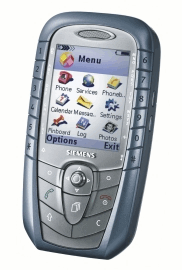

Features of the Siemens SX1 include:
Dimensions (Height x Width x Depth) 10.9 x 5.6 x 1.9 cm
Weight 116 g
Interface
Navigation
Directional pad 5-way
Jog Dial/Wheel No
Stylus No
Touch-sensitive screen No
Text input
Handwriting recognition No
Keypad Yes
Predictive text Yes
Virtual keyboard No
Voice input
Handsfree kit Yes
Handsfree speaker Yes
Voice dialing Yes
Voice command No
Voice recognition No
Processor, memory and operating system
Processor 130 MHz Texas Instruments OMAP 310
Volatile memory 4 MB
Non-volatile memory
Bundled memory
Operating system Symbian OS
Platform Series 60
Upgradeable OS Yes
Wide Area Networking (WAN)
Network:
Technology GSM
Frequencies 900/1800/1900 MHz
GPS No
Data services:
Fax Yes
HSCSD Yes
GPRS class Class B
GPRS multislot class 10
CDMA2000 No
Messaging:
E-mail POP3, IMAP4
SMS Yes
MMS Yes
Browser capabilities XHTML
Personal and Local Area Networking
Physical
Serial cable No
Serial cradle No
USB cable Yes
USB cradle Accessory
Wireless
Infrared Yes, IrDA
Bluetooth Yes
Bluetooth profiles HFP, SDAP, SSP
WLAN No
WLAN security No
On-board expansion slots
CompactFlash Type I/II No
Memory Stick/Duo/Pro No
MMC Yes
RS-MMC No
SD Card No
miniSD No
Desktop connectivity
Operating systems Windows 9x/ME/2000/XP
PIM suites Lotus Notes, Microsoft Outlook
Screen
Diagonal size Unknown inches
Resolution 176 x 220 pixels
Colour depth 16-bit
Technology TFD
Light source Yes
Adjustable brightness No
Sub-pixel font rendering No
Multimedia
Camera 0.3 MP
Camera flash No
Loudspeaker Yes
Earphone jack Yes
Microphone Yes
Volume control Hardware, Software
Power
Battery type Lithium Polymer
Battery capacity 1000 mAh
Battery life
Exchangeable Yes
Rechargeable Yes
Operating time:
Standby time 200 (Hours)
Talk time 240 (Minutes)
Other
Manufacturer Siemens
Bundled software
Manufacturer software
Third party software
Powered by a TI OMAP 310 running at 130 MHz, the Siemens SX1 does not appear to be any faster than competing smartphones Series 60 smartphones which all run at 109 MHz - however it is fully possible that the added processing power is required to be able to conduct MP3 playback. Memory is slim, though, as only 4 MB of non-volatile memory is available to users; 2 MB less than in the Nokia 6600, but far less than smartphones based on Windows Mobile platforms.
And speaking of slim, this is an expression which could well be applied to the battery life of the SX1. Powered as it is by a 1,000 mAh Lithium Polymer battery, its promised standby time of up to 200 hours is a complete ridicule: we maxed out at 48 hours with even minimal use of its functions - on a brand new handset. In comparison - and somewhat oddly - talk time fared much better, and averaged 200 minutes as opposed to the listed 240. Even compared with other Series 60 smartphones, the battery life of the SX1 is outright apalling.
Software
The latest version of Nokia's Series 60 platform is what powers the SX1, bringing with it niceties such as support for J2ME MIDP 2.0 and WAP 2.0, among more tangible things. The use of this platform - which has been tried and tested in millions of Nokia handsets - undoubtedly brings with it certain advantages, such as its well-known stability and simple user interface, along with a wide range of excellent browsing and messaging applications. Its PIM applications could benefit from somewhat more functionality being added for business users, but for consumers they are more than sufficient.
What's more, Siemens has introduced an excellent, omnipresent status bar which is unique to the SX1 and offers indicators for reception, battery life, messages and more. Another couple of extras have also been included, such as a File manager and World clock - both highly appreciated despite an admittedly low impact for many users.
The included Radio and MP3 Player applications are anything but low impact, however, and do a good job of pioneering audio playback in Series 60 smartphones. In fact, the SX1 is not only on par with Windows Mobile powered smartphones in this area, but even outperforms them all due to its inclusion of FM radio; we only wish they didn't have such an impact on battery life.
Further continuing a positive streak, the integrated VGA camera of the SX1 delivers results which are fully on par with cameras found in Nokia smartphones - well known for producing the best results of any handset on the market. Video recording works equally well, although this is limited to 15 FPS at QCIF resolution (176 x 144 pixels).
Siemens has also made some improvements to the standard-fare desktop connectivity application which Nokia bundles with its smartphones, among them the ability to manage MP3 files, simple photo processing and enabling users to send SMS and MMS messages from the desktop. Synchronization is unfortunately as slow as ever, however, despite the USB connectivity of the SX1: the solution opted for by Symbian is apparently inherently flawed seen from an end user aspect.
Availability
The Siemens SX1 is available now throughout Europe, and sells in the 800 USD range without subscription.
Conclusion
By choosing Nokia's Series 60 platform, Siemens has left its first smartphone wide open for comparisons with an excellent set of smartphones from the Finnish manufacturer. Fortunately for Siemens, the SX1 performs well, setting a high standard for multimedia in smartphones to come with its radio and MP3 playback capabilities. Business users are however recommended to stay away due to a combination of slow synchronization and poor on-device text input, while consumers should make sure they can live with charging their device on a daily basis.
- What's positive: Omnipresent status bar; radio and MP3 playback
- What's negative: Apalling battery life; poor text input; slow synchronization